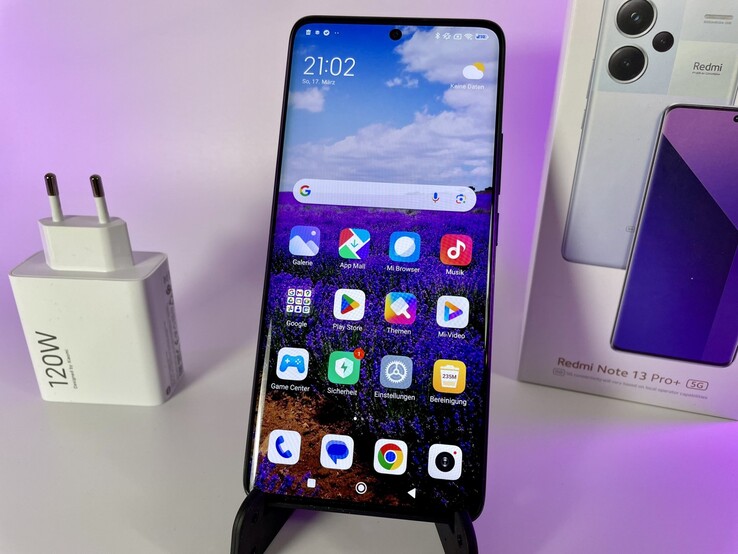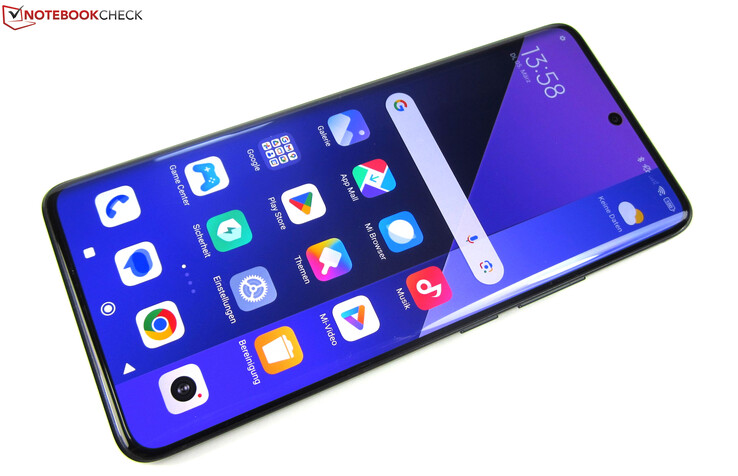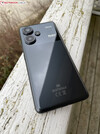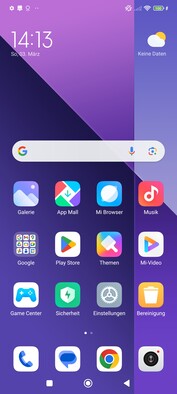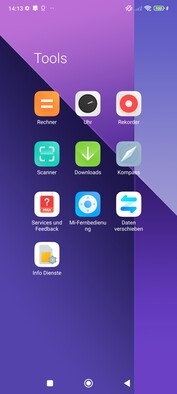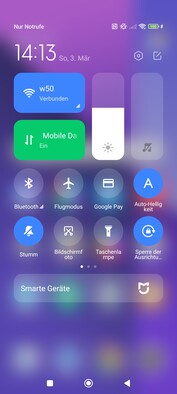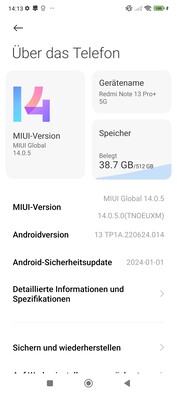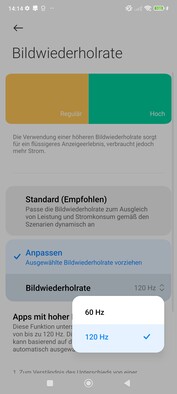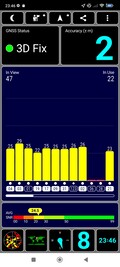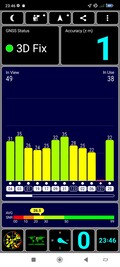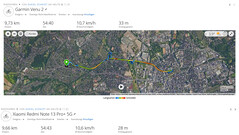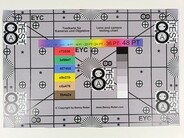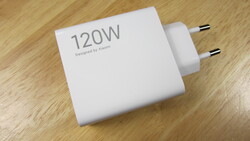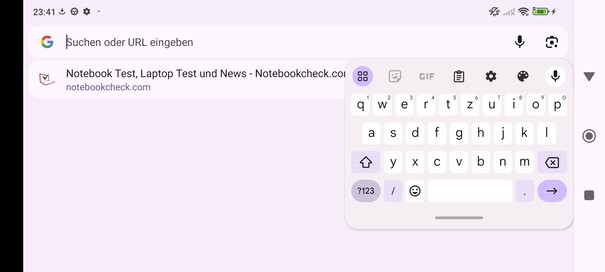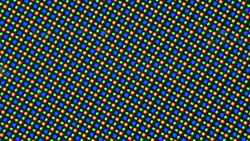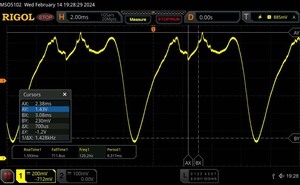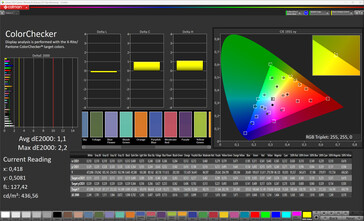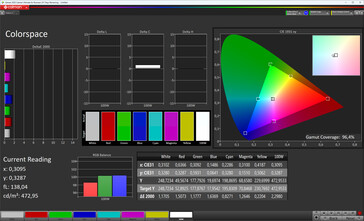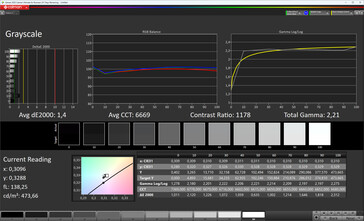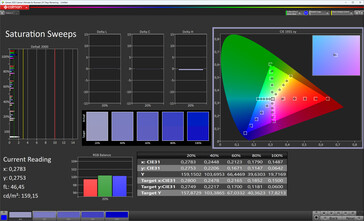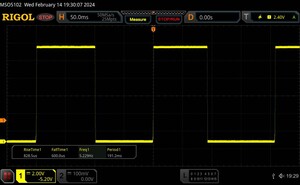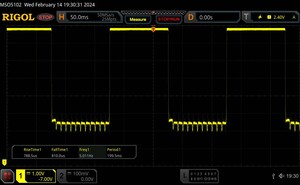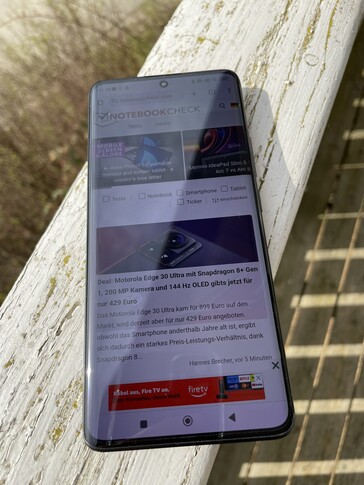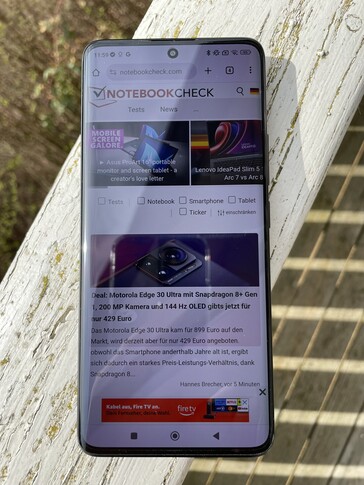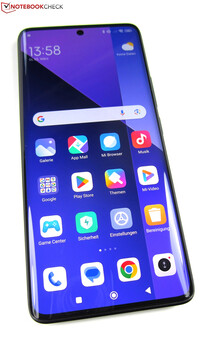Xiaomi Redmi Note 13 Pro+ 5G review – A new mid-range top dog?
The Redmi Note smartphones from Xiaomi are very popular, as the mid-range devices offer solid features and performance at a comparatively moderate price. This year's lineup, which consists of 5 models, is no different.
The 2024 Redmi Note series starts with the Xiaomi Redmi Note 13 4G which costs around US$220. This is followed by the Redmi Note 13 5G, the Redmi Note 13 Pro 4G and the Redmi Note 13 Pro 5G. At the top of the Redmi Note quintet is our test candidate, the top-of-the-range Redmi Note 13 Pro+ 5G, which starts at around US$460.
Despite its inconspicuous "plus" suffix, the Redmi Note 13 Pro+ 5G differs greatly from the Redmi Note 13 Pro 5G which is already being sold for close to the US$330 mark. Buyers also get a 200-megapixel camera but on top of this, they also get a faster SoC and, among other things, more charging power, a rounded display and a higher protection class, namely IP68.
Possible competitors compared
Rating | Date | Model | Weight | Drive | Size | Resolution | Price |
|---|---|---|---|---|---|---|---|
| 87.4 % v7 (old) | 03 / 2024 | Xiaomi Redmi Note 13 Pro+ 5G Dimensity 7200, Mali-G610 MP4 | 204.5 g | 512 GB UFS 3.1 Flash | 6.67" | 2712x1220 | |
| 87.1 % v7 (old) | 06 / 2023 | Google Pixel 7a Tensor G2, Mali-G710 MP7 | 193.5 g | 128 GB UFS 3.1 Flash | 6.10" | 2400x1080 | |
| 84.6 % v7 (old) | 10 / 2023 | Motorola Edge 40 Neo Dimensity 7030, Mali-G610 MP3 | 170 g | 256 GB UFS 3.1 Flash | 6.55" | 2400x1080 | |
| 86 % v7 (old) | 05 / 2023 | Samsung Galaxy A54 5G Exynos 1380, Mali-G68 MP5 | 202 g | 128 GB UFS 2.2 Flash | 6.40" | 2340x1080 | |
| 83.1 % v7 (old) | 09 / 2023 | Sony Xperia 10 V SD 695 5G, Adreno 619 | 159 g | 128 GB UFS 2.2 Flash | 6.10" | 2520x1080 | |
| 86.1 % v7 (old) | 03 / 2024 | Xiaomi Poco X6 Pro 5G Dimensity 8300-Ultra, Mali-G615 MP6 | 186 g | 512 GB UFS 4.0 Flash | 6.67" | 2712x1220 | |
| 85.8 % v7 (old) | 01 / 2024 | Xiaomi Redmi Note 13 Pro 5G SD 7s Gen 2, Adreno 710 | 187 g | 256 GB UFS 2.2 Flash | 6.67" | 2712x1220 |
Case - The Redmi Note 13 Pro+ 5G with a curved display and glass back
Xiaomi is breaking new ground with its Redmi Note 13 Pro+ 5G, as it is the first Redmi Note smartphone to not only have a curved display, but also an IP68 certification, making it dust- and waterproof. The screen is protected by durable Gorilla Glass Victus and comes with a screen protector pre-installed.
In all three color variants (Aurora Purple, Midnight Black and Moonlight White), the Redmi Note 13 Pro+ 5G has a glass back, which, in contrast to the Redmi Note 13 Pro 5G, is glossy instead of matte, making it quite the fingerprint magnet. This can be prevented by placing the smartphone in the supplied protective case. Otherwise, the camera module protrudes around 3 millimetres from the back cover, causing it to wobble back and forth.
In general, the Note 13 Pro+ 5G feels high-quality and looks good. Its stability is also good, as it did not warp or dent significantly in our test. In everyday use, you likely won't notice the fact that it only has a plastic frame. At 204 grams, the Xiaomi phone weighs about as much as the Samsung Galaxy A54.
Connectivity - Up to 12 GB RAM and 512 GB storage
There are two storage configurations of the Xiaomi Redmi Note 13 Pro+ 5G available:
- 8 GB RAM and 256 GB storage: approx. US$465
- 12 GB RAM and 512 GB storage: approx. US$540
Both storage variants make use of LPDDR5 RAM and fast UFS-3.1 storage. The Redmi Note 13 Pro 5G has to make do with slower LPDDR4 RAM and UFS-2.2 storage. You can't expand its storage because the phone has no microSD card slot. You can install 2 nano SIM cards or you can install one nano SIM card and use an eSIM.
As is typical for Xiaomi, the Redmi Note 13 Pro+ 5G features an IR blaster which you can use with compatible end devices such as smart TVs. Concessions to the price range include its always-on display, which is only active for 10 seconds after tapping, as well as its OTG-capable USB-C port, which is only connected internally at USB 2.0 speeds and achieved a data throughput of 32.3 MB/s in our copying test using our reference Samsung 980 Pro SSD. While the other smartphones in the current Redmi Note series have a 3.5 mm headphone jack, Xiaomi has omitted it from the Redmi Note 13 Pro+ 5G.
Software - MIUI 14 with plenty of bloatware
Xiaomi's user interface MIUI 14 runs on the Redmi Note 13 Pro+ 5G and it is based on Android 13. The smartphone is set to receive three years of Android upgrades and security patches will be rolled out for four years. At the time of testing in mid March, its last Android security update was from 01/01/2024, so not totally up-to-date.
Ex-works, the Xiaomi phone comes with tons of apps pre-installed that mostly fall under the category "bloatware". Only 473 GB are free to use on our freshly set-up 512-GB test device, as the OS and apps together take up almost 39 GB of its storage. Thankfully, the third-party apps can all be deleted.
On the other hand, it's a little more difficult to get rid of the advertizing that Xiaomi has integrated into its apps. Although you can find lots of instructions online that show you how to deactivate ads being shown, it does take quite a while until users have completed all of the steps.
Communication and GNSS - The Xiaomi phone with WiFi 6
With its 20 4G bands and 13 5G bands, the Xiaomi Redmi Note 13 Pro+ 5G supports all of the cellular frequencies important for the EU space, which is where our test was carried out. Use in other parts of the world should also most likely be possible without any big issues.
At short distances, the Redmi Note 13 Pro+ 5G uses Bluetooth 5.3 and WiFi 6. The latter is exclusive to the current Redmi Note series, as the four other devices have to make do with WiFi 5.
Connected to our Asus ROG Rapture AXE11000 reference router, the Redmi Note 13 Pro+ 5G achieves a good WiFi data throughput which is largely stable in both sending and receiving directions.
| Networking | |
| Xiaomi Redmi Note 13 Pro+ 5G | |
| iperf3 receive AXE11000 | |
| iperf3 transmit AXE11000 | |
| Google Pixel 7a | |
| iperf3 receive AXE11000 | |
| iperf3 transmit AXE11000 | |
| iperf3 transmit AXE11000 6GHz | |
| iperf3 receive AXE11000 6GHz | |
| Motorola Edge 40 Neo | |
| iperf3 transmit AXE11000 6GHz | |
| iperf3 receive AXE11000 6GHz | |
| Samsung Galaxy A54 5G | |
| iperf3 receive AXE11000 | |
| iperf3 transmit AXE11000 | |
| Sony Xperia 10 V | |
| iperf3 receive AXE11000 | |
| iperf3 transmit AXE11000 | |
| Xiaomi Poco X6 Pro 5G | |
| iperf3 receive AXE11000 | |
| iperf3 transmit AXE11000 | |
| Xiaomi Redmi Note 13 Pro 5G | |
| iperf3 receive AXE11000 | |
| iperf3 transmit AXE11000 | |
| Average of class Smartphone | |
| iperf3 receive AXE11000 | |
| iperf3 transmit AXE11000 | |
| iperf3 transmit AXE11000 6GHz | |
| iperf3 receive AXE11000 6GHz | |
The Redmi Note 13 Pro+ 5G determines its current location with the help of the satellite navigation services GPS, Glonass, Galileo, Beidou and QZSS, each in single-band. Outside, the smartphone achieves a high accuracy of up to 1 metre.
Our practical test showed the Xiaomi phone to be well equipped as a navigation device if you don't rely on complete accuracy. On our 10-kilometre bike trip, the Redmi Note 13 Pro+ 5G recorded our route a lot less precisely than the Garmin Venu 2 fitness smartwatch which we used as our reference device.
Telephone features and call quality
Aside from VoLTE, the Xiaomi Redmi Note 13 Pro+ 5G also supports WLAN calls and can house two nano-SIM cards. Alternatively, you can activate one eSIM—but at the cost of having to give up one of the physical SIM slots.
In our test, the Xiaomi phone delivered good call quality during telephone calls and quite effectively suppressed background noises. Our voice was transmitted clearly when using the loudspeaker, too.
Cameras - A 200-MP camera with a Samsung ISOCELL HP3
The Redmi Note 13 Pro+ 5G shares its camera specs with the Redmi Note 13 Pro 5G but in practical use, our test sample's photos ended up looking better. Only their selfie cameras are about the same. This lens sits within a punch-hole cutout, has a 16-MP resolution, looks decent during video calls and takes nice-looking portrait shots that show good levels of detail.
The same as its predecessor, the Redmi Note 12 Pro+ 5G, the new model's main camera also uses a 200-MP image sensor. The 1/1.4-inch Samsung ISOCELL HP3 combines 16 neighboring pixels into one pixel as standard, resulting in 12.5-MP photos. The image sensor is supported by electronic and optical image stabilization. This 16-to-1 pixel-binning ensures that the light yield remains high in poor lighting conditions. As it doesn't feature a tele lens, you can only zoom digitally up to 10x.
The 200 MP picture mode lets you make use of the Samsung ISOCELL HP3's full resolution. However, you should make sure there is enough light to achieve good photos—this is explicitly pointed out by the camera software. The rest of the camera setup isn't nearly as good as the main camera, as it doesn't offer anything special—only an 8 MP ultra-wide-angle camera and a 2 MP macro sensor.
In daylight, the phone's main camera takes excellent photos which depict colors naturally and don't have to shy away from shots taken on much more expensive smartphone cameras. Although there is a difference between classes, you do have to look quite closely to see it. A difference becomes noticeable when casting a glance at very bright and very dark areas of a photo, as better camera lenses such as those of the Google Pixel 8 Pro of the Samsung Galaxy S24 Ultra manage to achieve even better levels of detail.
When compared to the rest of its price class, the Redmi Note 13 Pro+ 5G's photo quality is above average, even in low-light conditions. The main camera benefits from its large f/1.65 aperture, with which it can still get a lot out of the subjects. Although the level of detail decreases at night, only a little image noise creeps into the images.
The smartphone can record good-quality videos at a maximum of 4K and 30fps. Switching between the main and ultra-wide angle lenses is possible up to 1080p. Using this mode, you can record video at up to 60fps.
In terms of the other cameras, the Xiaomi phone keeps a respectful distance from upper-class smartphones, which is clear from its lack of a telephoto lens alone. Its ultra-wide-angle camera uses a slightly different white balance than its main camera and takes solid pictures that are no worse than those of cheaper smartphones. Details and colors are good, but they are blurred at the edges. The macro camera has a resolution of 2 MP and is of little practical use, as the main camera takes better close-ups with its digital zoom.
Image comparison
Choose a scene and navigate within the first image. One click changes the position on touchscreens. One click on the zoomed-in image opens the original in a new window. The first image shows the scaled photograph of the test device.
Daylight photo 1Daylight photo 2Ultra-wide angle5x zoomLow-light photoIn our test lab, the main camera showed that it can capture colors very accurately in optimal lighting conditions (maximum Delta-E of 8.05). It also reproduced the test chart very sharply. At 1 lux residual light, the test chart remained recognizable, but was only displayed very darkly.
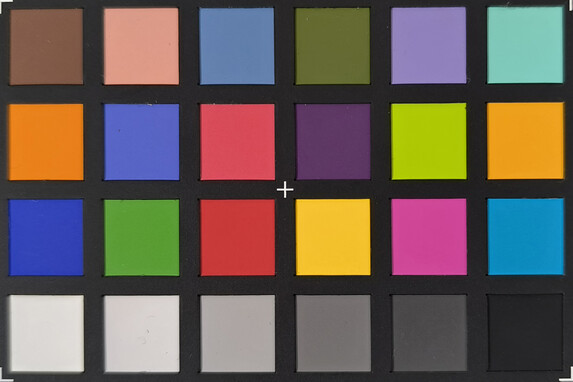

Accessories and warranty - 120-watt power supply included
Xiaomi delivers the Redmi Note 13 Pro+ 5G with a 120-watt power supply (up to 20V/6A), USB-C cable, SIM tool, protective case, short instruction manual including warranty information and a further leaflet with safety instructions.
In the US, the Redmi Note 13 Pro+ 5G features a standard 12-month warranty.
Input devices & operation - The fingerprint sensor measures your heart rate
The Redmi Note 13 Pro+ 5G's touchscreen reacts very promptly and precisely to inputs. When gaming, its touch-sampling rate rises from the standard 240 Hz to up to 2160 Hz. The physical buttons give you crisp feedback, sit firmly within the case and can barely be wiggled to the sides. Its linear vibration motor is quiet and even at the highest setting, it is still pretty subtle.
The fingerprint sensor that sits beneath the phone's screen unlocked the device quickly and reliably during our test. In addition, it can be used to measure your heart rate but of course, it can't replace a medical device. A further biometric authentication method is its 2D facial recognition. Face Unlock relies on good ambient light and in our case, it worked just as easily as unlocking the phone via the fingerprint sensor.
Display - 120-Hz AMOLED screen with up to 1700 cd/m² brightness
The Redmi Note 13 Pro+ 5G's 6.67-inch AMOLED panel has a resolution of 2712 x 1220 pixels, resulting in a high pixel density of 446 PPI. Aside from HDR10 and HDR10+, the screen also supports Dolby Vision and HLG. In the standard setting, the AMOLED panel automatically switches to 60 or 120 Hz depending on the content displayed. Optionally, the refresh rate can be permanently set to 60 or 120 Hz.
When depicting a pure white background, the AMOLED panel achieves an average brightness of 1233 cd/m², meaning it shines brighter than average for this price class. However, it can do even more. When depicting even parts light and dark areas (APL18 measurement), its maximum brightness rises to 1714 cd/m², which is quite close to the value of 1800 nits that is specified by the manufacturer. When showing HDR content, we couldn't elicit anything over 1178 cd/m² out of the display. Using the lowest brightness setting, it shines at 2.36 cd/m².
To mitigate the OLED flickering, the Redmi Note 13 Pro+ 5G uses PWM dimming at up to 1920 Hz. We only measured 1428 Hz at minimum brightness (first Rigol screenshot), but this should not cause any complaints for sensitive users. However, we also noticed a low-frequency flickering of 120 Hz with a very flat amplitude curve. This can also be seen in the second screenshot of the Rigol measurement series ("min."), which shows practically the same as the first screenshot. The main difference: Due to the scaling, a different zoom level was used for the "min." image, which makes the amplitude look so flat there. The 120 Hz flickering is probably Black Frame Insertion (BFI), which is used to reduce motion blur.
| |||||||||||||||||||||||||
Brightness Distribution: 98 %
Center on Battery: 1240 cd/m²
Contrast: ∞:1 (Black: 0 cd/m²)
ΔE ColorChecker Calman: 1.1 | ∀{0.5-29.43 Ø4.79}
ΔE Greyscale Calman: 1.4 | ∀{0.09-98 Ø5}
96.4% sRGB (Calman 2D)
Gamma: 2.21
CCT: 6669 K
| Xiaomi Redmi Note 13 Pro+ 5G AMOLED, 2712x1220, 6.7" | Google Pixel 7a OLED, 2400x1080, 6.1" | Motorola Edge 40 Neo pOLED, 2400x1080, 6.6" | Samsung Galaxy A54 5G Super AMOLED, 2340x1080, 6.4" | Sony Xperia 10 V OLED, 2520x1080, 6.1" | Xiaomi Poco X6 Pro 5G AMOLED, 2712x1220, 6.7" | Xiaomi Redmi Note 13 Pro 5G AMOLED, 2712x1220, 6.7" | |
|---|---|---|---|---|---|---|---|
| Screen | -10% | -49% | -45% | -9% | -4% | -36% | |
| Brightness middle (cd/m²) | 1240 | 1006 -19% | 966 -22% | 940 -24% | 933 -25% | 1034 -17% | 1205 -3% |
| Brightness (cd/m²) | 1233 | 1010 -18% | 957 -22% | 935 -24% | 944 -23% | 1035 -16% | 1177 -5% |
| Brightness Distribution (%) | 98 | 95 -3% | 97 -1% | 99 1% | 97 -1% | 96 -2% | 90 -8% |
| Black Level * (cd/m²) | |||||||
| Colorchecker dE 2000 * | 1.1 | 1.1 -0% | 1.87 -70% | 2.4 -118% | 1.1 -0% | 1.1 -0% | 1.51 -37% |
| Colorchecker dE 2000 max. * | 2.2 | 2.5 -14% | 4.34 -97% | 3.2 -45% | 1.7 23% | 1.9 14% | 4.07 -85% |
| Greyscale dE 2000 * | 1.4 | 1.5 -7% | 2.5 -79% | 2.2 -57% | 1.8 -29% | 1.4 -0% | 2.5 -79% |
| Gamma | 2.21 100% | 2.25 98% | 2.272 97% | 2.05 107% | 2.29 96% | 2.22 99% | 2.175 101% |
| CCT | 6669 97% | 6531 100% | 6582 99% | 6422 101% | 6611 98% | 6674 97% | 6407 101% |
* ... smaller is better
Screen Flickering / PWM (Pulse-Width Modulation)
| Screen flickering / PWM detected | 120 Hz | ||
The display backlight flickers at 120 Hz (worst case, e.g., utilizing PWM) . The frequency of 120 Hz is very low, so the flickering may cause eyestrain and headaches after extended use. In comparison: 53 % of all tested devices do not use PWM to dim the display. If PWM was detected, an average of 8167 (minimum: 5 - maximum: 343500) Hz was measured. | |||
Measurement series with fixed zoom level and different brightness settings
Using the preset color mode Vivid, the AMOLED panel uses the DCI-P3 color space. If you switch to Standard, the screen switches to the significantly smaller sRGB color space but achieves the best picture quality.
Display Response Times
| ↔ Response Time Black to White | ||
|---|---|---|
| 1.43 ms ... rise ↗ and fall ↘ combined | ↗ 0.8285 ms rise | |
| ↘ 0.6 ms fall | ||
| The screen shows very fast response rates in our tests and should be very well suited for fast-paced gaming. In comparison, all tested devices range from 0.1 (minimum) to 240 (maximum) ms. » 7 % of all devices are better. This means that the measured response time is better than the average of all tested devices (20.3 ms). | ||
| ↔ Response Time 50% Grey to 80% Grey | ||
| 1.6 ms ... rise ↗ and fall ↘ combined | ↗ 0.7885 ms rise | |
| ↘ 0.81 ms fall | ||
| The screen shows very fast response rates in our tests and should be very well suited for fast-paced gaming. In comparison, all tested devices range from 0.165 (minimum) to 636 (maximum) ms. » 6 % of all devices are better. This means that the measured response time is better than the average of all tested devices (31.7 ms). | ||
Outside, the viewing-angle stable AMOLED panel remains legible even in direct sunlight. You can also select a sunlight mode via the display settings which automatically adjusts the screen brightness to strong sunlight. In doing so, however, you do have to deactivate the brightness sensor which, during our test, proved to not make the most sense. If you adjust the brightness manually, you can only elicit a maximum brightness of 516 cd/m² from the display. Nothing changed about this when we activated the sunlight mode.
Performance - The Redmi Note 13 Pro+ 5G with a MediaTek Dimensity 7200-Ultra
The Redmi Note 13 Pro+ 5G has been given the most powerful SoC within the Redmi Note series, namely the MediaTek Dimensity 7200-Ultra. The processor, manufactured with a 4 nm structure width, works with 2 ARM Cortex A715 power cores that clock at up to 2.8 GHz. There is also a second cluster with 6 ARM Cortex A510 power cores, which achieve a maximum clock frequency of 2 GHz.
Performance-wise, the Redmi Note 13 Pro+ 5G leaves most mid-range smartphones up to US$400 in the dust. Its system speed is high, apps run fast and even having multiple programs open at once doesn't make the Xiaomi phone break out in a sweat. In our test, we did note the occasional tiny stutter but in total, its operation is buttery smooth.
The Redmi Note 13 Pro+ 5G not only outperformed the Redmi Note 13 Pro 5G in the synthetic benchmarks, but also similarly equipped comparison devices such as the Motorola Edge 40 Neo and the Samsung Galaxy A54. However, benchmarks such as Crossmark and PCMark for Android didn't particularly suit it. In terms of performance, the Redmi Note 13 Pro+ 5G is best compared with the Google Pixel 7a.
Our GPU tests painted the same picture as the synthetic benchmarks. The Xiaomi Poco X6 Pro 5G and the Google Pixel 7a were faster than the Redmi Note 13 Pro+ 5G but in turn, our test sample beat the other comparison devices. The ARM Mali-G610 MC4 takes care of graphics calculations within the MediaTek Dimensity 7200-Ultra.
GFXBench (DX / GLBenchmark) 2.7: T-Rex Onscreen | 1920x1080 T-Rex Offscreen
GFXBench 3.0: on screen Manhattan Onscreen OGL | 1920x1080 1080p Manhattan Offscreen
GFXBench 3.1: on screen Manhattan ES 3.1 Onscreen | 1920x1080 Manhattan ES 3.1 Offscreen
GFXBench: on screen Car Chase Onscreen | 1920x1080 Car Chase Offscreen | on screen Aztec Ruins High Tier Onscreen | 2560x1440 Aztec Ruins High Tier Offscreen | on screen Aztec Ruins Normal Tier Onscreen | 1920x1080 Aztec Ruins Normal Tier Offscreen | 3840x2160 4K Aztec Ruins High Tier Offscreen
| 3DMark / Wild Life Extreme Unlimited | |
| Xiaomi Poco X6 Pro 5G | |
| Google Pixel 7a | |
| Xiaomi Redmi Note 13 Pro+ 5G | |
| Samsung Galaxy A54 5G | |
| Xiaomi Redmi Note 13 Pro 5G | |
| Motorola Edge 40 Neo | |
| Sony Xperia 10 V | |
| 3DMark / Wild Life Extreme | |
| Xiaomi Poco X6 Pro 5G | |
| Google Pixel 7a | |
| Xiaomi Redmi Note 13 Pro+ 5G | |
| Samsung Galaxy A54 5G | |
| Xiaomi Redmi Note 13 Pro 5G | |
| Motorola Edge 40 Neo | |
| Sony Xperia 10 V | |
| 3DMark / Wild Life Unlimited Score | |
| Xiaomi Poco X6 Pro 5G | |
| Google Pixel 7a | |
| Xiaomi Redmi Note 13 Pro+ 5G | |
| Xiaomi Redmi Note 13 Pro 5G | |
| Samsung Galaxy A54 5G | |
| Motorola Edge 40 Neo | |
| Sony Xperia 10 V | |
| 3DMark / Wild Life Score | |
| Google Pixel 7a | |
| Xiaomi Redmi Note 13 Pro+ 5G | |
| Xiaomi Redmi Note 13 Pro 5G | |
| Samsung Galaxy A54 5G | |
| Motorola Edge 40 Neo | |
| Sony Xperia 10 V | |
| Xiaomi Poco X6 Pro 5G | |
| 3DMark / Sling Shot Extreme (ES 3.1) Unlimited Physics | |
| Xiaomi Poco X6 Pro 5G | |
| Google Pixel 7a | |
| Samsung Galaxy A54 5G | |
| Motorola Edge 40 Neo | |
| Xiaomi Redmi Note 13 Pro 5G | |
| Xiaomi Redmi Note 13 Pro+ 5G | |
| Sony Xperia 10 V | |
| 3DMark / Sling Shot Extreme (ES 3.1) Unlimited Graphics | |
| Xiaomi Poco X6 Pro 5G | |
| Google Pixel 7a | |
| Xiaomi Redmi Note 13 Pro+ 5G | |
| Xiaomi Redmi Note 13 Pro 5G | |
| Samsung Galaxy A54 5G | |
| Motorola Edge 40 Neo | |
| Sony Xperia 10 V | |
| 3DMark / Sling Shot Extreme (ES 3.1) Unlimited | |
| Xiaomi Poco X6 Pro 5G | |
| Google Pixel 7a | |
| Xiaomi Redmi Note 13 Pro+ 5G | |
| Xiaomi Redmi Note 13 Pro 5G | |
| Samsung Galaxy A54 5G | |
| Motorola Edge 40 Neo | |
| Sony Xperia 10 V | |
| GFXBench (DX / GLBenchmark) 2.7 / T-Rex Onscreen | |
| Xiaomi Poco X6 Pro 5G | |
| Xiaomi Redmi Note 13 Pro+ 5G | |
| Motorola Edge 40 Neo | |
| Samsung Galaxy A54 5G | |
| Google Pixel 7a | |
| Xiaomi Redmi Note 13 Pro 5G | |
| Sony Xperia 10 V | |
| GFXBench (DX / GLBenchmark) 2.7 / T-Rex Offscreen | |
| Xiaomi Poco X6 Pro 5G | |
| Google Pixel 7a | |
| Xiaomi Redmi Note 13 Pro+ 5G | |
| Xiaomi Redmi Note 13 Pro 5G | |
| Samsung Galaxy A54 5G | |
| Motorola Edge 40 Neo | |
| Sony Xperia 10 V | |
| GFXBench 3.0 / Manhattan Onscreen OGL | |
| Xiaomi Poco X6 Pro 5G | |
| Google Pixel 7a | |
| Xiaomi Redmi Note 13 Pro+ 5G | |
| Samsung Galaxy A54 5G | |
| Motorola Edge 40 Neo | |
| Xiaomi Redmi Note 13 Pro 5G | |
| Sony Xperia 10 V | |
| GFXBench 3.0 / 1080p Manhattan Offscreen | |
| Xiaomi Poco X6 Pro 5G | |
| Google Pixel 7a | |
| Xiaomi Redmi Note 13 Pro+ 5G | |
| Samsung Galaxy A54 5G | |
| Motorola Edge 40 Neo | |
| Xiaomi Redmi Note 13 Pro 5G | |
| Sony Xperia 10 V | |
| GFXBench 3.1 / Manhattan ES 3.1 Onscreen | |
| Xiaomi Poco X6 Pro 5G | |
| Google Pixel 7a | |
| Xiaomi Redmi Note 13 Pro 5G | |
| Xiaomi Redmi Note 13 Pro+ 5G | |
| Samsung Galaxy A54 5G | |
| Motorola Edge 40 Neo | |
| Sony Xperia 10 V | |
| GFXBench 3.1 / Manhattan ES 3.1 Offscreen | |
| Xiaomi Poco X6 Pro 5G | |
| Google Pixel 7a | |
| Xiaomi Redmi Note 13 Pro+ 5G | |
| Samsung Galaxy A54 5G | |
| Motorola Edge 40 Neo | |
| Sony Xperia 10 V | |
| Xiaomi Redmi Note 13 Pro 5G | |
| GFXBench / Car Chase Onscreen | |
| Xiaomi Poco X6 Pro 5G | |
| Google Pixel 7a | |
| Xiaomi Redmi Note 13 Pro+ 5G | |
| Samsung Galaxy A54 5G | |
| Motorola Edge 40 Neo | |
| Xiaomi Redmi Note 13 Pro 5G | |
| Sony Xperia 10 V | |
| GFXBench / Car Chase Offscreen | |
| Xiaomi Poco X6 Pro 5G | |
| Google Pixel 7a | |
| Xiaomi Redmi Note 13 Pro+ 5G | |
| Samsung Galaxy A54 5G | |
| Xiaomi Redmi Note 13 Pro 5G | |
| Motorola Edge 40 Neo | |
| Sony Xperia 10 V | |
| GFXBench / Aztec Ruins High Tier Onscreen | |
| Xiaomi Poco X6 Pro 5G | |
| Google Pixel 7a | |
| Xiaomi Redmi Note 13 Pro+ 5G | |
| Samsung Galaxy A54 5G | |
| Motorola Edge 40 Neo | |
| Xiaomi Redmi Note 13 Pro 5G | |
| Sony Xperia 10 V | |
| GFXBench / Aztec Ruins High Tier Offscreen | |
| Xiaomi Poco X6 Pro 5G | |
| Google Pixel 7a | |
| Xiaomi Redmi Note 13 Pro+ 5G | |
| Samsung Galaxy A54 5G | |
| Xiaomi Redmi Note 13 Pro 5G | |
| Motorola Edge 40 Neo | |
| Sony Xperia 10 V | |
| GFXBench / Aztec Ruins Normal Tier Onscreen | |
| Xiaomi Poco X6 Pro 5G | |
| Google Pixel 7a | |
| Xiaomi Redmi Note 13 Pro+ 5G | |
| Samsung Galaxy A54 5G | |
| Motorola Edge 40 Neo | |
| Xiaomi Redmi Note 13 Pro 5G | |
| Sony Xperia 10 V | |
| GFXBench / Aztec Ruins Normal Tier Offscreen | |
| Xiaomi Poco X6 Pro 5G | |
| Google Pixel 7a | |
| Xiaomi Redmi Note 13 Pro+ 5G | |
| Xiaomi Redmi Note 13 Pro 5G | |
| Samsung Galaxy A54 5G | |
| Motorola Edge 40 Neo | |
| Sony Xperia 10 V | |
| GFXBench / 4K Aztec Ruins High Tier Offscreen | |
| Xiaomi Poco X6 Pro 5G | |
| Google Pixel 7a | |
| Xiaomi Redmi Note 13 Pro+ 5G | |
| Samsung Galaxy A54 5G | |
| Xiaomi Redmi Note 13 Pro 5G | |
| Motorola Edge 40 Neo | |
| Sony Xperia 10 V | |
Surfing the web is as easy as pie for the Redmi Note 13 Pro+ 5G. Even larger websites load quickly and waiting times prove to be a major exception for the phone. In turn, the browser benchmarks weren't able to reflect this, as the Xiaomi device came in just below average.
| Jetstream 2 - 2.0 Total Score | |
| Average of class Smartphone (23.8 - 387, n=150, last 2 years) | |
| Xiaomi Poco X6 Pro 5G (Chrome 122.0.6261.64) | |
| Xiaomi Redmi Note 13 Pro 5G (Chrome 120) | |
| Google Pixel 7a (Chrome 114) | |
| Motorola Edge 40 Neo (Chrome 118) | |
| Samsung Galaxy A54 5G (Chrome 112) | |
| Xiaomi Redmi Note 13 Pro+ 5G (Chrome 122.0.6261.90) | |
| Average MediaTek Dimensity 7200 (76.6 - 83.8, n=2) | |
| Sony Xperia 10 V (Chrome 116) | |
| Speedometer 2.0 - Result 2.0 | |
| Average of class Smartphone (15.2 - 643, n=130, last 2 years) | |
| Xiaomi Poco X6 Pro 5G (Chrome 122.0.6261.64) | |
| Google Pixel 7a (Chrome 114) | |
| Xiaomi Redmi Note 13 Pro+ 5G (Chrome 122.0.6261.90) | |
| Average MediaTek Dimensity 7200 (104 - 112, n=2) | |
| Motorola Edge 40 Neo (Chrome 118) | |
| Xiaomi Redmi Note 13 Pro 5G (Chrome 120) | |
| Sony Xperia 10 V (Chrome 116) | |
| Samsung Galaxy A54 5G (Chrome 112) | |
| WebXPRT 4 - Overall | |
| Average of class Smartphone (27 - 306, n=143, last 2 years) | |
| Xiaomi Poco X6 Pro 5G (Chrome 122.0.6261.64) | |
| Xiaomi Redmi Note 13 Pro 5G (Chrome 120) | |
| Google Pixel 7a (Chrome 114) | |
| Motorola Edge 40 Neo (Chrome 118) | |
| Average MediaTek Dimensity 7200 (86 - 125, n=2) | |
| Samsung Galaxy A54 5G (Chrome 112) | |
| Xiaomi Redmi Note 13 Pro+ 5G (Chrome 122.0.6261.90) | |
| Sony Xperia 10 V (Chrome 116) | |
| WebXPRT 3 - Overall | |
| Average of class Smartphone (38 - 380, n=41, last 2 years) | |
| Xiaomi Poco X6 Pro 5G (Chrome 122.0.6261.64) | |
| Average MediaTek Dimensity 7200 (92 - 185, n=2) | |
| Samsung Galaxy A54 5G (Chrome 112) | |
| Motorola Edge 40 Neo (Chrome 118) | |
| Xiaomi Redmi Note 13 Pro+ 5G (Chrome 122.0.6261.90) | |
| Octane V2 - Total Score | |
| Average of class Smartphone (2228 - 121337, n=196, last 2 years) | |
| Xiaomi Poco X6 Pro 5G (Chrome 122.0.6261.64) | |
| Google Pixel 7a (Chrome 114) | |
| Xiaomi Redmi Note 13 Pro+ 5G (Chrome 122.0.6261.90) | |
| Xiaomi Redmi Note 13 Pro 5G (Chrome 120) | |
| Motorola Edge 40 Neo (Chrome 118) | |
| Samsung Galaxy A54 5G (Chrome 112) | |
| Sony Xperia 10 V (Chrome 116) | |
| Average MediaTek Dimensity 7200 (18562 - 39060, n=2) | |
| Mozilla Kraken 1.1 - Total | |
| Average MediaTek Dimensity 7200 (1296 - 1570, n=2) | |
| Sony Xperia 10 V (Chrome 116) | |
| Motorola Edge 40 Neo (Chrome 118) | |
| Xiaomi Redmi Note 13 Pro+ 5G (Chrome 122.0.6261.90) | |
| Samsung Galaxy A54 5G (Chrome 112) | |
| Average of class Smartphone (257 - 28190, n=151, last 2 years) | |
| Xiaomi Redmi Note 13 Pro 5G (Chrome 120) | |
| Xiaomi Poco X6 Pro 5G (Chrome 122.0.6261.64) | |
| Google Pixel 7a (Chrome 114) | |
* ... smaller is better
Thanks to its UFS-3.1 storage, the Redmi Note 13 Pro+ 5G achieves high data throughput and loads even larger apps quickly. Other smartphones within the same price class can hardly compete. The only exception is the Xiaomi Poco X6 Pro which boasts UFS-4.0 storage.
| Xiaomi Redmi Note 13 Pro+ 5G | Google Pixel 7a | Motorola Edge 40 Neo | Samsung Galaxy A54 5G | Sony Xperia 10 V | Xiaomi Poco X6 Pro 5G | Xiaomi Redmi Note 13 Pro 5G | Average 512 GB UFS 3.1 Flash | Average of class Smartphone | |
|---|---|---|---|---|---|---|---|---|---|
| AndroBench 3-5 | -16% | -18% | -58% | -55% | 83% | -31% | 6% | 16% | |
| Sequential Read 256KB (MB/s) | 1921.64 | 1624.39 -15% | 1004.4 -48% | 528.32 -73% | 444.54 -77% | 3824.7 99% | 946.8 -51% | 1867 ? -3% | 2188 ? 14% |
| Sequential Write 256KB (MB/s) | 1702.4 | 996.44 -41% | 930.9 -45% | 335.39 -80% | 438.02 -74% | 3642.57 114% | 808.2 -53% | 1303 ? -23% | 1801 ? 6% |
| Random Read 4KB (MB/s) | 248.21 | 229.44 -8% | 279.5 13% | 236.23 -5% | 175.72 -29% | 355.7 43% | 239.2 -4% | 288 ? 16% | 292 ? 18% |
| Random Write 4KB (MB/s) | 265.29 | 263.81 -1% | 284.1 7% | 70.52 -73% | 165.15 -38% | 467.74 76% | 220.5 -17% | 354 ? 33% | 336 ? 27% |
Games - 120 frames per second remain the exception
Current games can be played well on the Redmi Note 13 Pro+ 5G. The graphically less-demanding Asphalt 9 balanced out near the 60fps mark. The same can be said for PUBG Mobile using the HD/Extreme setting. The frame rate fluctuates a lot more when playing the graphically demanding Genshin Impact, at times falling below 35fps. This isn't terribly smooth anymore.
The Xiaomi couldn't show off its 120-Hz screen, at least in the games we tested. At least PUBG Mobile offers us a 90fps mode in the lowest graphics setting, namely smooth.
We determined the game frame rates with our Gamebench test tool.
Emissions - The Redmi Note 13 Pro+ 5G with stereo speakers
Temperature
During use, the Redmi Note 13 Pro+ 5G stays nice and cool. We only noted temperatures above body temperature after our one-hour stress test using the Burnout benchmark. Even so, a maximum of 42.3 °C doesn't feel uncomfortably warm. As the Wild Life stress tests from 3DMark showed, the Xiaomi smartphone can access its full performance practically all the time.
(±) The maximum temperature on the upper side is 42.3 °C / 108 F, compared to the average of 35.2 °C / 95 F, ranging from 21.9 to 247 °C for the class Smartphone.
(±) The bottom heats up to a maximum of 41.1 °C / 106 F, compared to the average of 34 °C / 93 F
(+) In idle usage, the average temperature for the upper side is 27.5 °C / 82 F, compared to the device average of 32.9 °C / 91 F.
3DMark Wild Life Stress Test
| 3DMark | |
| Wild Life Stress Test Stability | |
| Sony Xperia 10 V | |
| Xiaomi Redmi Note 13 Pro 5G | |
| Motorola Edge 40 Neo | |
| Xiaomi Redmi Note 13 Pro+ 5G | |
| Samsung Galaxy A54 5G | |
| Xiaomi Poco X6 Pro 5G | |
| Google Pixel 7a | |
| Wild Life Extreme Stress Test | |
| Xiaomi Redmi Note 13 Pro 5G | |
| Samsung Galaxy A54 5G | |
| Xiaomi Redmi Note 13 Pro+ 5G | |
| Motorola Edge 40 Neo | |
| Sony Xperia 10 V | |
| Xiaomi Poco X6 Pro 5G | |
| Google Pixel 7a | |
| Solar Bay Stress Test Stability | |
| Xiaomi Poco X6 Pro 5G | |
Speakers
The Xiaomi phone's stereo speakers produce a fairly balanced sound by smartphone standards, with very linear mids and highs that do not sound distorted at maximum volume. However, there is no bass.
External audio devices can be connected via USB-C or Bluetooth 5.3 for better sound. The Redmi Note 13 Pro+ 5G supports almost all current Bluetooth codecs, including AAC, SBC, aptX HD, aptX TWS+ and LHDC V1 to V5.
Xiaomi Redmi Note 13 Pro+ 5G audio analysis
(+) | speakers can play relatively loud (88.7 dB)
Bass 100 - 315 Hz
(-) | nearly no bass - on average 27.1% lower than median
(±) | linearity of bass is average (9.1% delta to prev. frequency)
Mids 400 - 2000 Hz
(+) | balanced mids - only 3.3% away from median
(+) | mids are linear (5% delta to prev. frequency)
Highs 2 - 16 kHz
(+) | balanced highs - only 3.6% away from median
(+) | highs are linear (5% delta to prev. frequency)
Overall 100 - 16.000 Hz
(±) | linearity of overall sound is average (16.1% difference to median)
Compared to same class
» 5% of all tested devices in this class were better, 4% similar, 91% worse
» The best had a delta of 12%, average was 35%, worst was 134%
Compared to all devices tested
» 25% of all tested devices were better, 5% similar, 70% worse
» The best had a delta of 4%, average was 24%, worst was 134%
Samsung Galaxy A54 5G audio analysis
(+) | speakers can play relatively loud (88.7 dB)
Bass 100 - 315 Hz
(-) | nearly no bass - on average 23.2% lower than median
(±) | linearity of bass is average (11.3% delta to prev. frequency)
Mids 400 - 2000 Hz
(±) | reduced mids - on average 6.4% lower than median
(+) | mids are linear (5.5% delta to prev. frequency)
Highs 2 - 16 kHz
(±) | higher highs - on average 6% higher than median
(+) | highs are linear (2.8% delta to prev. frequency)
Overall 100 - 16.000 Hz
(±) | linearity of overall sound is average (17.8% difference to median)
Compared to same class
» 13% of all tested devices in this class were better, 8% similar, 78% worse
» The best had a delta of 12%, average was 35%, worst was 134%
Compared to all devices tested
» 35% of all tested devices were better, 8% similar, 57% worse
» The best had a delta of 4%, average was 24%, worst was 134%
Battery life - Completely charged in under 30 minutes
Power consumption
While the Redmi Note 13 Pro 5G made do with a 67-watt power supply unit, the Redmi Note 13 Pro+ 5G can use its 120-watt power supply unit to its full advantage. When switched off, the smartphone was fully charged after a speedy 28 minutes during the test.
According to Xiaomi, charging should only take 19 minutes. However, we couldn't verify this ourselves despite activating battery options such as increase charging speed and accelerate charging. The closest we could get to the manufacturer's claim was to leave the phone switched on and connect it to the power supply when the battery was at 1 per cent. It was then charged after 24 minutes.
Under load and in idle mode, the Redmi Note 13 Pro+ 5G doesn't require too much power. Although its basic consumption is somewhat high, it runs much more frugally than the slower Redmi Note 13 Pro 5G at maximum load.
| Off / Standby | |
| Idle | |
| Load |
|
Key:
min: | |
| Xiaomi Redmi Note 13 Pro+ 5G 5000 mAh | Google Pixel 7a 4385 mAh | Motorola Edge 40 Neo 5000 mAh | Samsung Galaxy A54 5G 5000 mAh | Sony Xperia 10 V 5000 mAh | Xiaomi Poco X6 Pro 5G 5000 mAh | Xiaomi Redmi Note 13 Pro 5G 5100 mAh | Average MediaTek Dimensity 7200 | Average of class Smartphone | |
|---|---|---|---|---|---|---|---|---|---|
| Power Consumption | 26% | 19% | 16% | 41% | -11% | 14% | 3% | 5% | |
| Idle Minimum * (Watt) | 1.22 | 0.62 49% | 1 18% | 0.75 39% | 0.56 54% | 1.11 9% | 1.3 -7% | 1.015 ? 17% | 0.856 ? 30% |
| Idle Average * (Watt) | 1.47 | 0.87 41% | 1.2 18% | 1.51 -3% | 0.91 38% | 1.14 22% | 1.4 5% | 1.74 ? -18% | 1.437 ? 2% |
| Idle Maximum * (Watt) | 1.58 | 0.95 40% | 1.3 18% | 1.62 -3% | 0.98 38% | 1.16 27% | 1.6 -1% | 1.825 ? -16% | 1.612 ? -2% |
| Load Average * (Watt) | 8.09 | 6.11 24% | 5.2 36% | 4.91 39% | 5.34 34% | 12.33 -52% | 2.5 69% | 6.13 ? 24% | 7.1 ? 12% |
| Load Maximum * (Watt) | 9.49 | 11.81 -24% | 9.2 3% | 8.93 6% | 5.46 42% | 15.34 -62% | 9.1 4% | 8.7 ? 8% | 11.2 ? -18% |
* ... smaller is better
Power consumption: Geekbench (150 cd/m²)
Power consumption: GFXBench (150 cd/m²)
Runtimes
The Redmi Note 13 Pro+ 5G delivers good runtimes. At 15:13 hours during the simulated web-surfing test and 15:37 hours when playing back video in a continuous loop, it doesn't have quite as much stamina as the comparison devices. The Samsung Galaxy A54 and the Sony Xperia 10 V in particular lasted for much longer during both realistic test scenarios. The Redmi Note 13 Pro 5G, too, managed a little longer.
| Xiaomi Redmi Note 13 Pro+ 5G 5000 mAh | Google Pixel 7a 4385 mAh | Motorola Edge 40 Neo 5000 mAh | Samsung Galaxy A54 5G 5000 mAh | Sony Xperia 10 V 5000 mAh | Xiaomi Poco X6 Pro 5G 5000 mAh | Xiaomi Redmi Note 13 Pro 5G 5100 mAh | |
|---|---|---|---|---|---|---|---|
| Battery runtime | -7% | 19% | 26% | 65% | -3% | 7% | |
| Reader / Idle (h) | 26.4 | 22.1 -16% | 40.7 54% | 43.2 64% | 67.8 157% | 30.3 15% | 29.8 13% |
| H.264 (h) | 15.6 | 20.4 31% | 20.5 31% | 25.1 61% | 26.9 72% | 16.1 3% | 19 22% |
| WiFi v1.3 (h) | 15.2 | 13.7 -10% | 14.4 -5% | 15.7 3% | 19.3 27% | 15.7 3% | 16.7 10% |
| Load (h) | 6.2 | 4.2 -32% | 5.9 -5% | 4.7 -24% | 6.5 5% | 4.2 -32% | 5.1 -18% |
Pros
Cons
Verdict on the Xiaomi Redmi Note 13 Pro+ 5G
While the Xiaomi Redmi Note 13 Pro 5G already performed nearly flawlessly during our test, the Redmi Note 13 Pro+ 5G now sets the bar even higher.
An extensive hardware package speaks for the Redmi Note 13 Pro+ 5G, which is now available for around US$480. Highlights include its Mediatek Dimensity 7200-Ultra which offers a lot of power as well as its 200-MP camera that doesn't just show impressive numbers, but it can also currently be classed as the best on the market for a mid-range smartphone.
The Redmi Note 13 Pro+ 5G is a good mid-range smartphone with strong features. In particular, it boasts a fast SoC, a 200-MP camera and a bright AMOLED panel.
The Redmi Note 13 Pro+ 5G deserves even more praise for its bright AMOLED panel, good stereo speakers and impressive runtimes. Our test sample managed to set itself apart from the Redmi Note 13 Pro 5G through its more powerful SoC in particular and despite its identical camera setup, it takes better photos. More features exclusive to the Redmi-Note top dog include a curved display, WiFi 6, an IP68 certification, fast storage and charging at 120 watts.
Unfortunately, a true always-on display, USB-C 3.x and wireless charging are all features that Xiaomi has reserved for its more expensive 13 and 14 series models. It is also a shame that the manufacturer has done away with the 3.5-mm audio jack in its top-dog Redmi Note model of all things—but not in the rest of the Redmi Note lineup. We also aren't fans of the bloatware which comes pre-installed into the MIUI-ROM and the advertizing that is integrated into some Xiaomi apps.
Aside from the Redmi Note 13 Pro 5G, alternatives to the Redmi Note 13 Pro+ 5G include the Google Pixel 7a which is slightly faster than our test device. Together with the Samsung Galaxy A54, it also has a longer update period than the Redmi Note 13 Pro+ 5G.
Price and availability
The version of the Redmi Note 13 Pro+ 5G with 512 GB of storage can currently be found on Amazon for US$477.99.
Xiaomi Redmi Note 13 Pro+ 5G
- 03/18/2024 v7 (old)
Manuel Masiero
Transparency
The selection of devices to be reviewed is made by our editorial team. The test sample was provided to the author as a loan by the manufacturer or retailer for the purpose of this review. The lender had no influence on this review, nor did the manufacturer receive a copy of this review before publication. There was no obligation to publish this review. As an independent media company, Notebookcheck is not subjected to the authority of manufacturers, retailers or publishers.
This is how Notebookcheck is testing
Every year, Notebookcheck independently reviews hundreds of laptops and smartphones using standardized procedures to ensure that all results are comparable. We have continuously developed our test methods for around 20 years and set industry standards in the process. In our test labs, high-quality measuring equipment is utilized by experienced technicians and editors. These tests involve a multi-stage validation process. Our complex rating system is based on hundreds of well-founded measurements and benchmarks, which maintains objectivity. Further information on our test methods can be found here.




